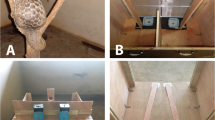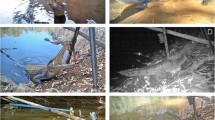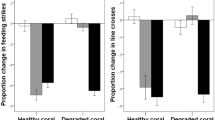Abstract
A potential benefit of living in a colony is that animals may gain information about the location of good foraging sites from other colony members1–3. The role of information transfer as a major benefit favouring the evolution of coloniality is, however, very poorly understood4. Information transfer has been demonstrated for only a few colonial vertebrate species5–7, but not all colonial species share information8–10. Here I report that colonial ospreys (Pandion haliaetus, L.) not only transfer information about foraging locations, but that they discriminate among fish species brought back by other colony members, and respond only to schooling prey species. This information significantly reduces the search times needed for informed birds to capture patchily-distributed prey species. This is the first demonstration of a colonial vertebrate discriminating between prey species with different spatial distributions brought back by returning foragers, and selectively using information about location of prey species to increase foraging efficiency.
This is a preview of subscription content, access via your institution
Access options
Subscribe to this journal
Receive 51 print issues and online access
$199.00 per year
only $3.90 per issue
Buy this article
- Purchase on Springer Link
- Instant access to full article PDF
Prices may be subject to local taxes which are calculated during checkout
Similar content being viewed by others
References
Ward, P. Ibis 107, 173–214 (1965).
Ward, P. & Zahavi, A. Ibis 115, 517–534 (1973).
Alexander, R. D. A Rev. Ecol. Syst. 5, 325–383 (1974).
Witenberger, J. F. & G. L. Hunt, Jr in Avian Biology (eds Farner, D. S. & King, J. R.) 8, 1–78 (Academic, New York, 1985).
Bayer, R. D. Auk 99, 31–40 (1982).
Brown, C. R. Science 234, 83–85 (1986).
Waltz, E. C. Anim. Behav. 35, 48–59 (1987).
Loman, J. & Tamm, S. Am. Nat. 115, 285–289 (1980).
Andersson, M., Götmark, F. & Wiklund, C. G. Behavl. ecol. Sociobiol 9, 199–202 (1986).
Kiis, A. & Møller, A. P. Anim. Behav. 34, 1251–1255 (1986).
Cramp, S. in The Birds of the Western Palearctic. 2, (Oxford University Press, 1980).
Prévost, Y. A. MSc. Thesis, McGill Univ. Montreal (1977).
Spitzer, P. & Poole, A. Am. Birds 34, 234–241 (1980).
Greene, E. & Freedman, B. Can. Fd Nat. 100, 470–473 (1986).
Abbott, C. C. in The Home Life of the Osprey (Acar, London, 1911).
Greene, E., Greene, A. & Freedman, B. in Biology and Management of Bald Eagles and Ospreys (eds Bird, D. M., Seymour, N. R. & Gerrard, J. M.) 257–267 (Harpell, Montreal, 1983).
Tyler, A. V. Fish. Res. Board Canada 28, 1727–1732 (1971).
Pearcy, W. G. Bull. Bingham Oceanographic Coll. 18, 1–78 (1962).
Messieh, S. Envir. Biol. Fish. 2, 195–210 (1977).
Murawski, S. A. & Cole, C. F. Trans. Am. Fish. Soc 107, 535–542 (1978).
Steele, D. H. J. Fish. Res. Bd. Can. 29, 1267–1314 (1963).
Weatherhead, P. J. Am. Nat. 121, 237–243 (1983).
Harmata, A. Raptor Res. 16, 103–111 (1982).
Spitzer, P. thesis, Cornell Univ., Ithaca (1980).
Poole, A. Auk 99, 781–784 (1982).
Hagen, J. thesis. Northern Carolina State Univ., Raleigh (1986).
Author information
Authors and Affiliations
Rights and permissions
About this article
Cite this article
Greene, E. Individuals in an osprey colony discriminate between high and low quality information. Nature 329, 239–241 (1987). https://doi.org/10.1038/329239a0
Received:
Accepted:
Issue Date:
DOI: https://doi.org/10.1038/329239a0
This article is cited by
-
A multidimensional framework for studying social predation strategies
Nature Ecology & Evolution (2017)
-
Making sense of information
Nature (1990)
-
Collective decision making through food recruitment
Insectes Sociaux (1990)
-
Winter foraging at carcasses by three sympatric corvids, with emphasis on recruitment by the raven, Corvus corax
Behavioral Ecology and Sociobiology (1988)
Comments
By submitting a comment you agree to abide by our Terms and Community Guidelines. If you find something abusive or that does not comply with our terms or guidelines please flag it as inappropriate.



